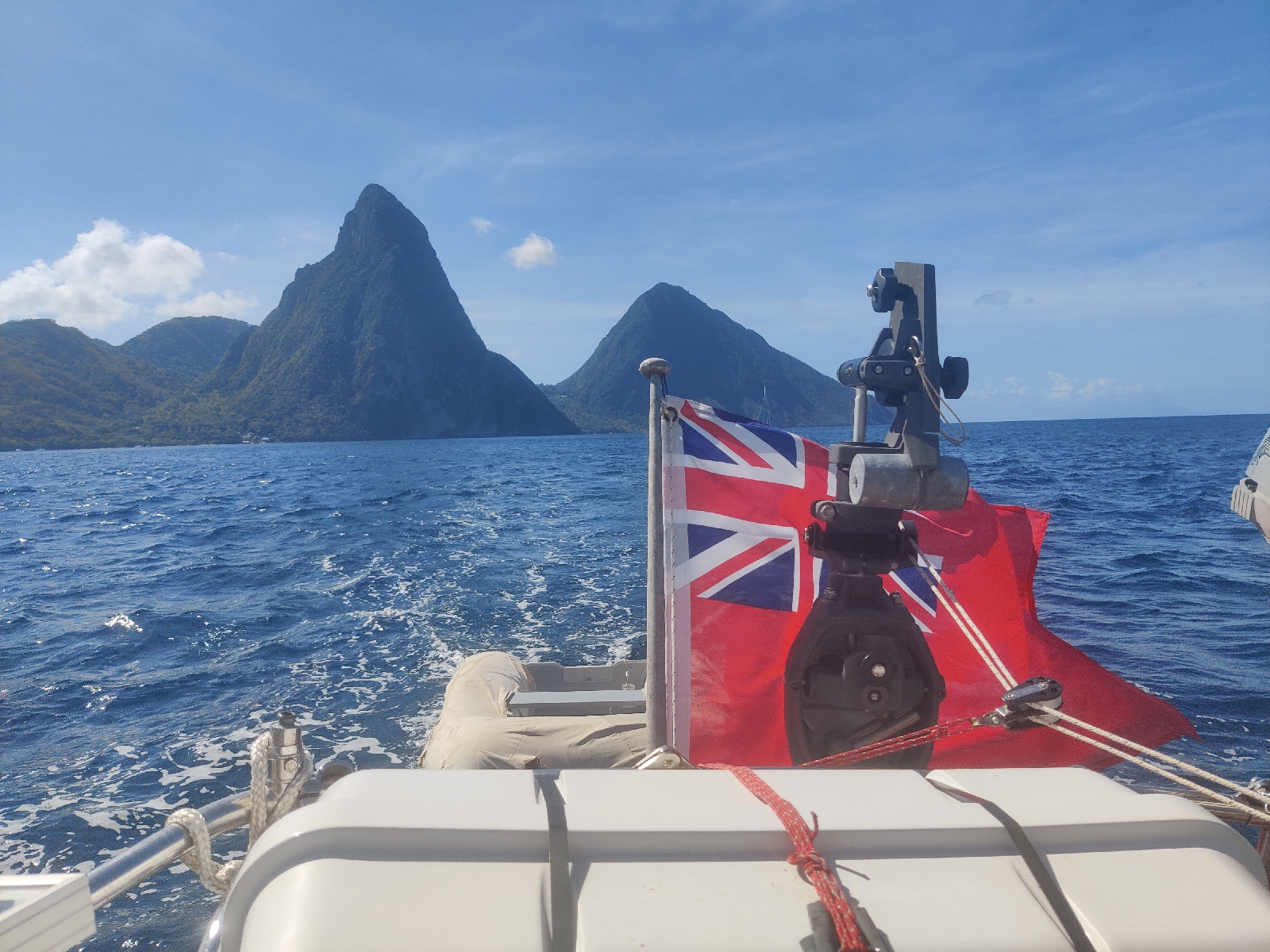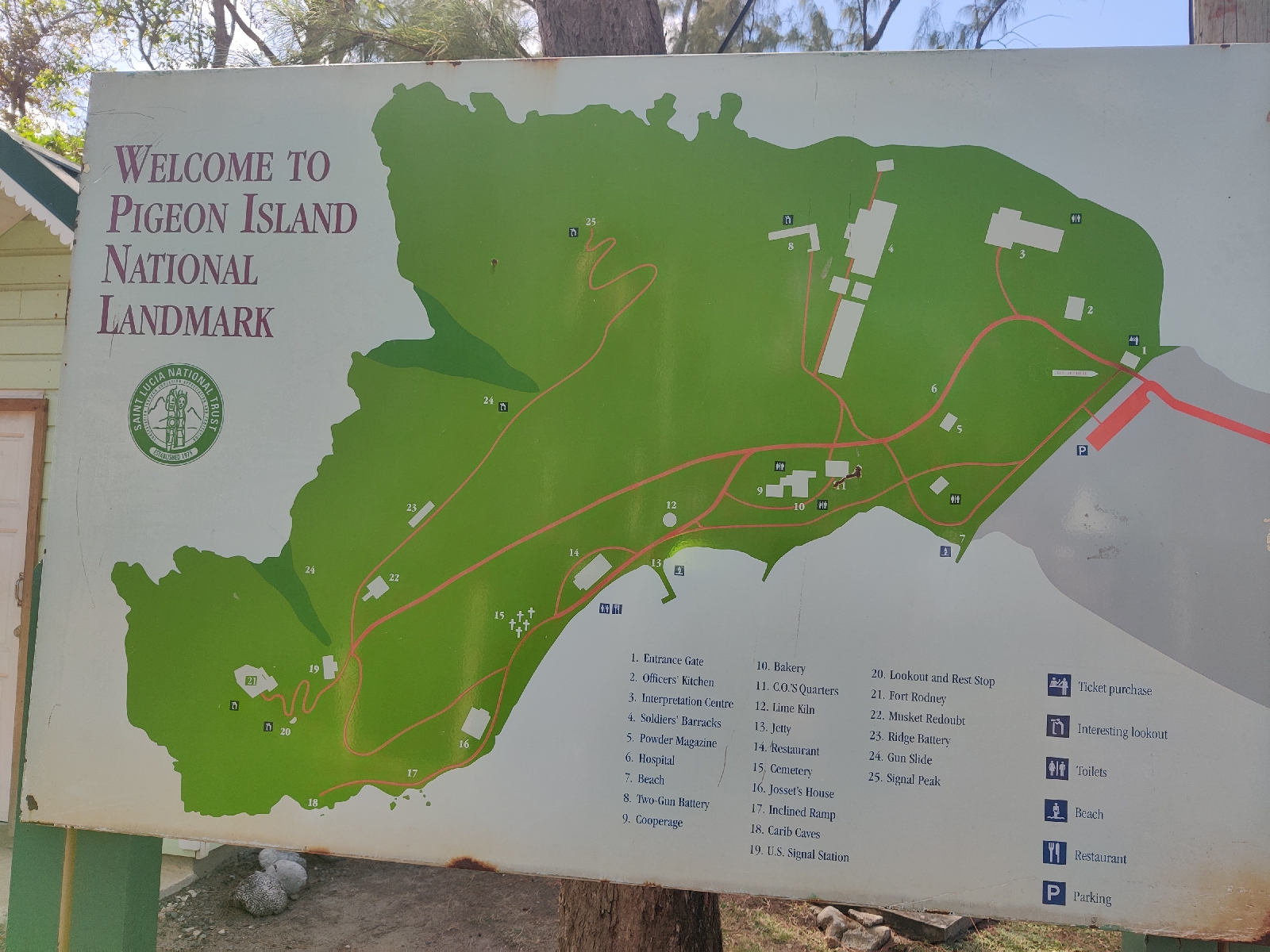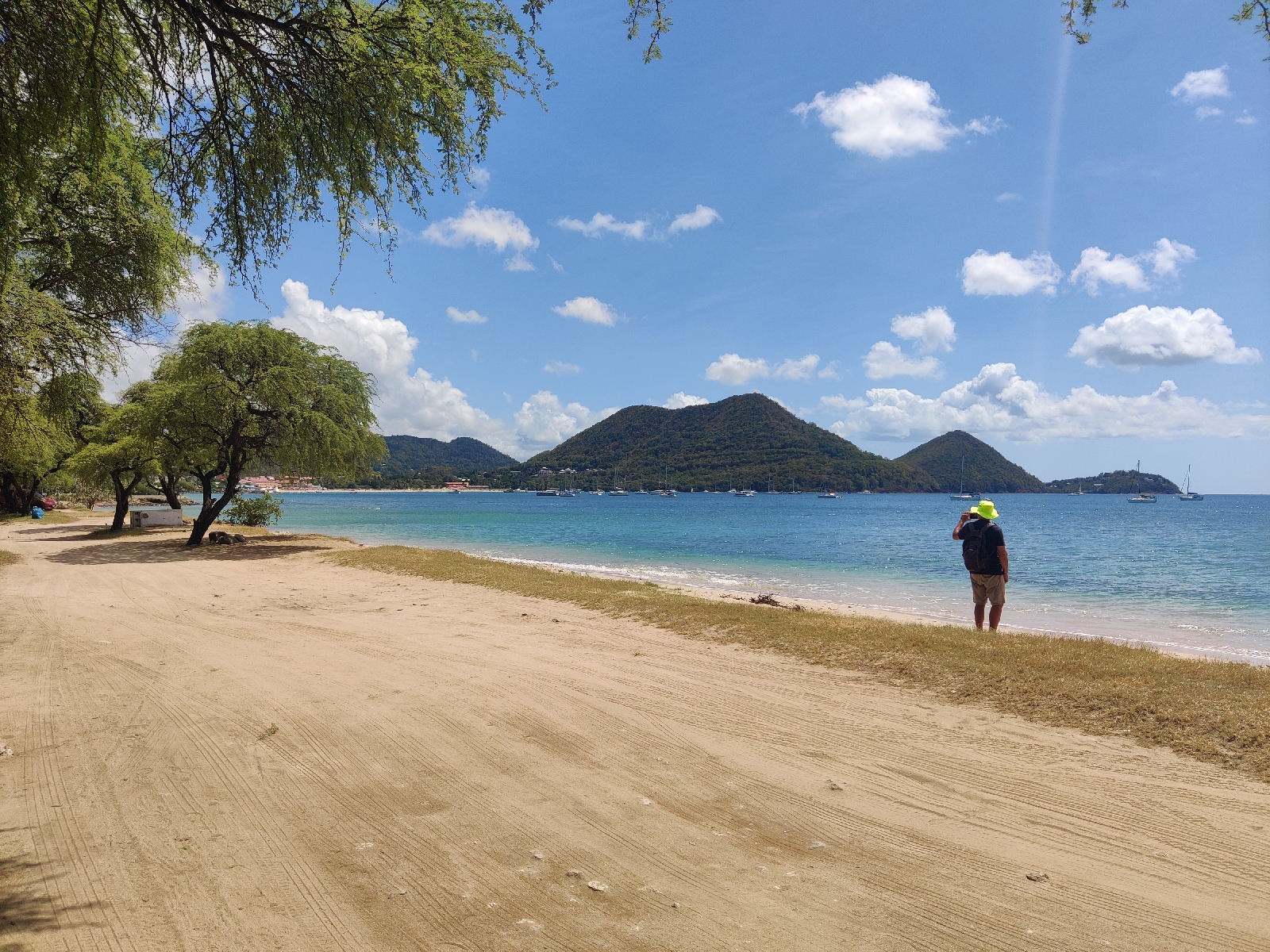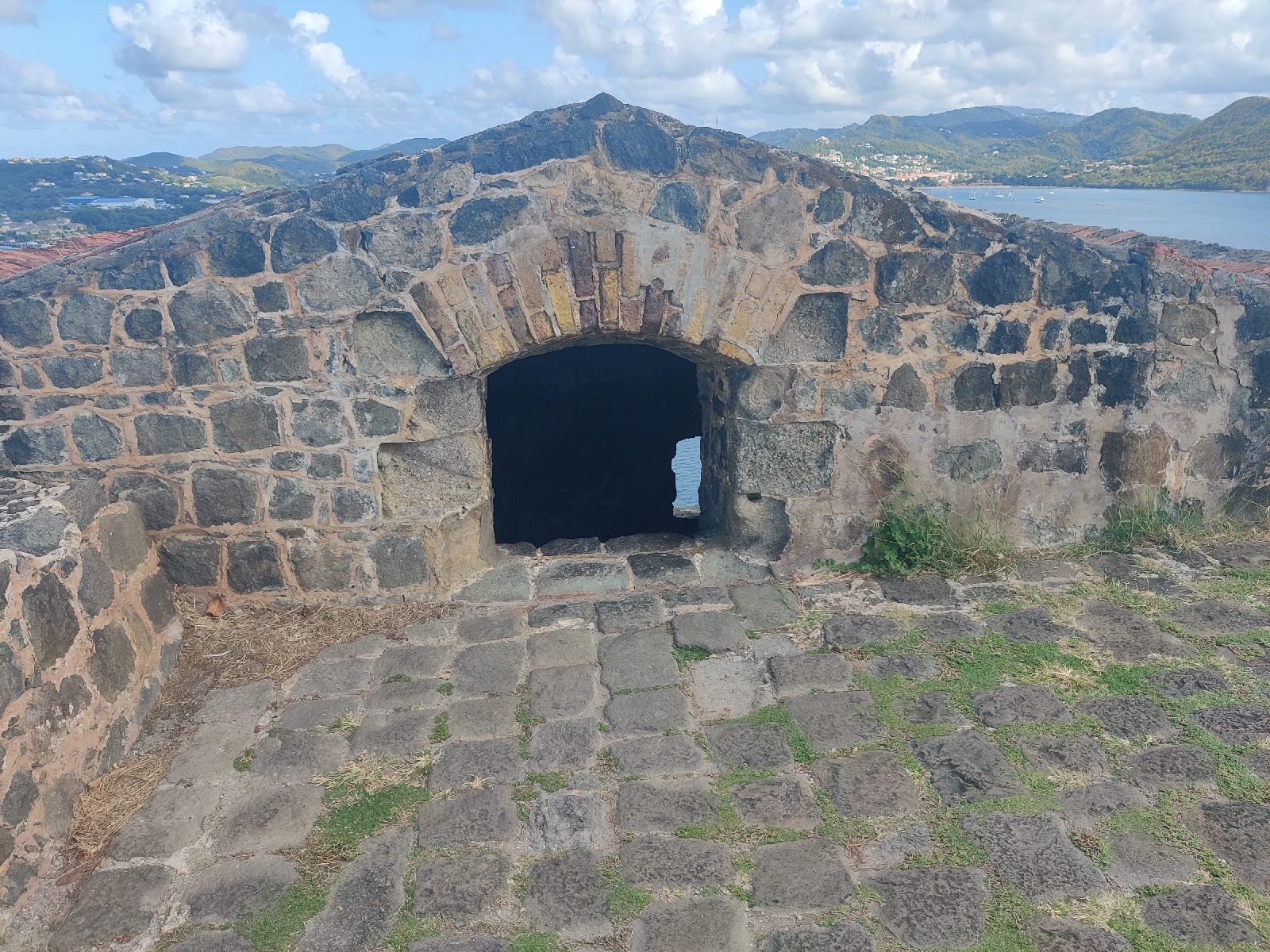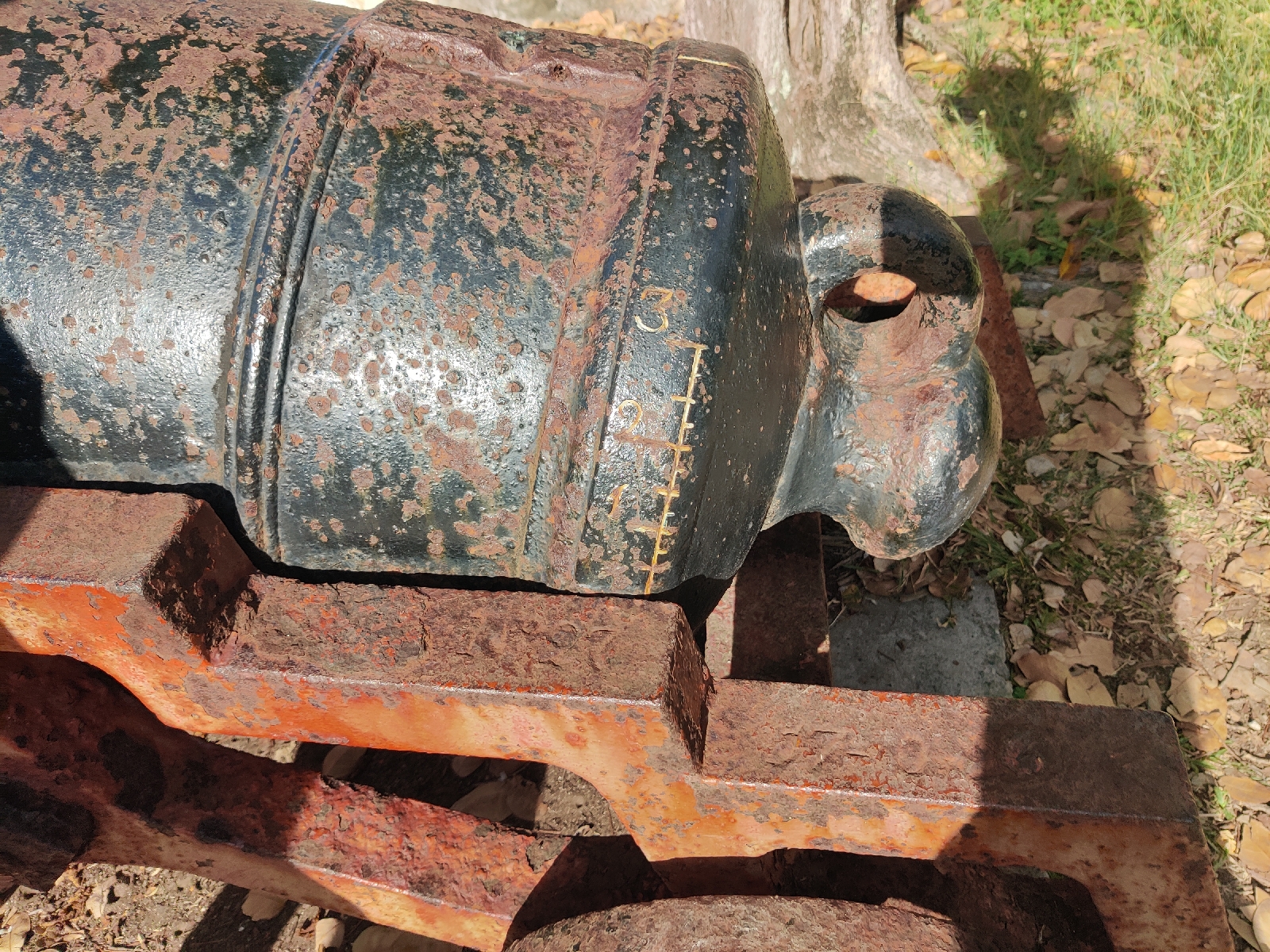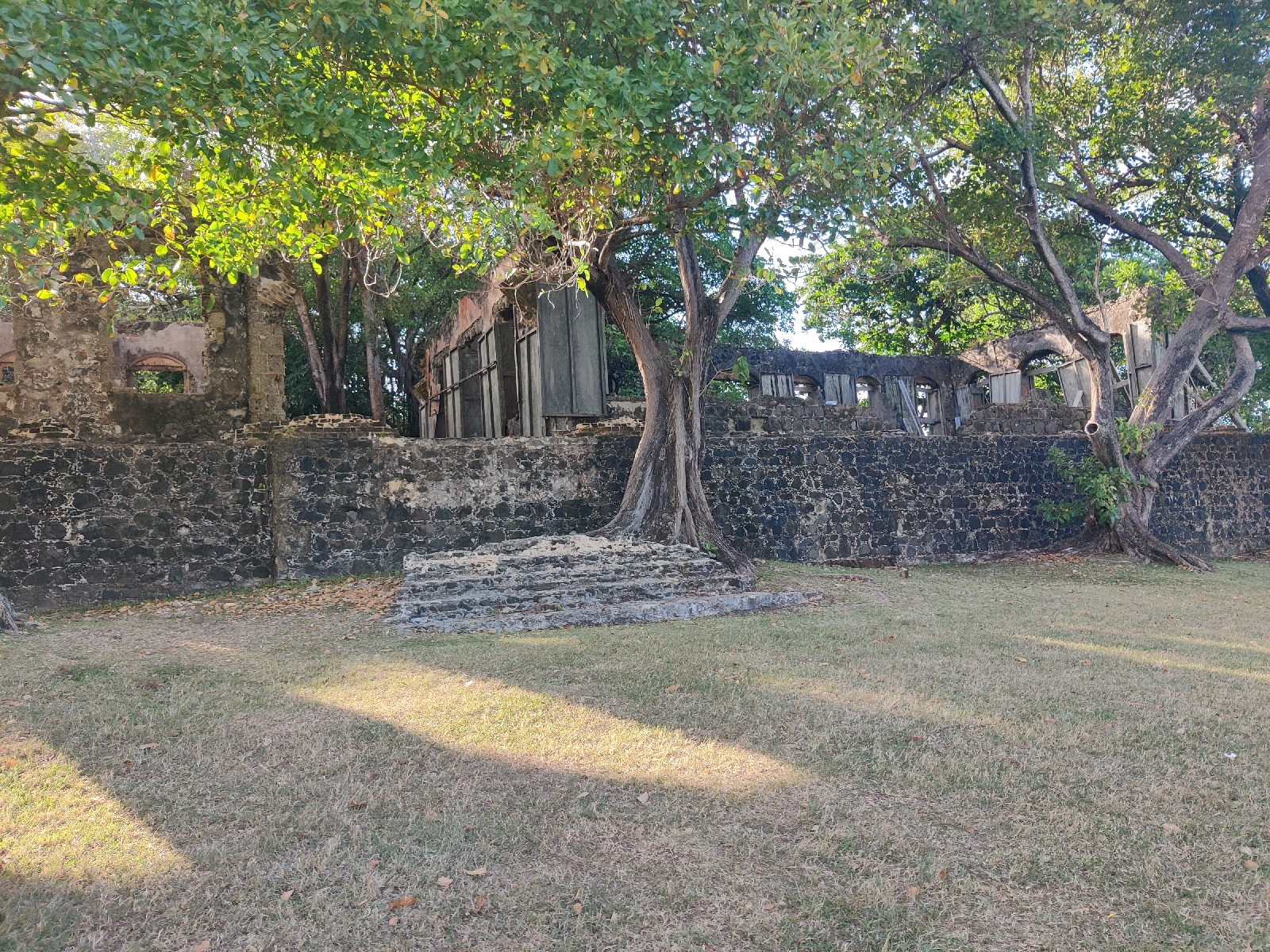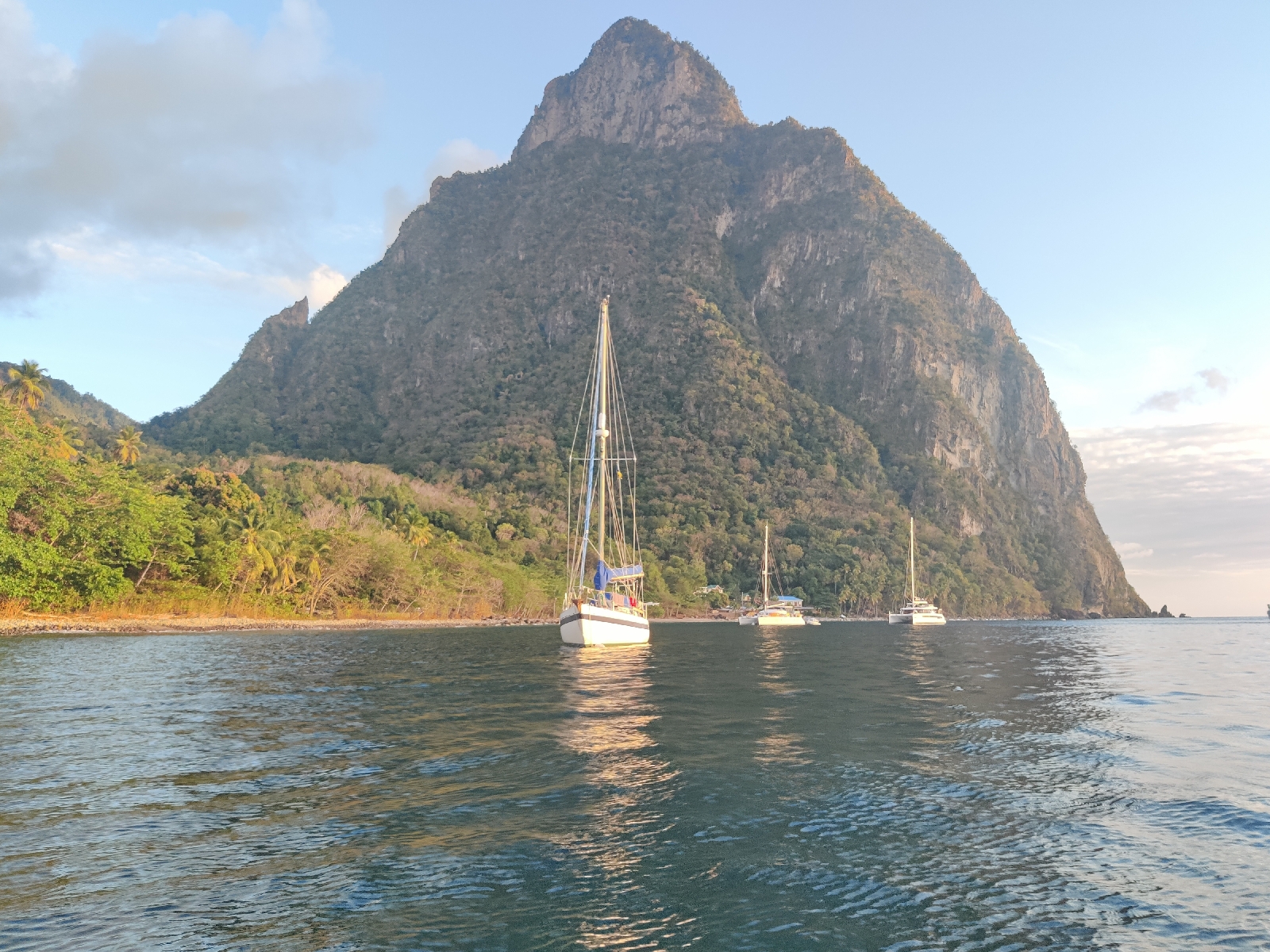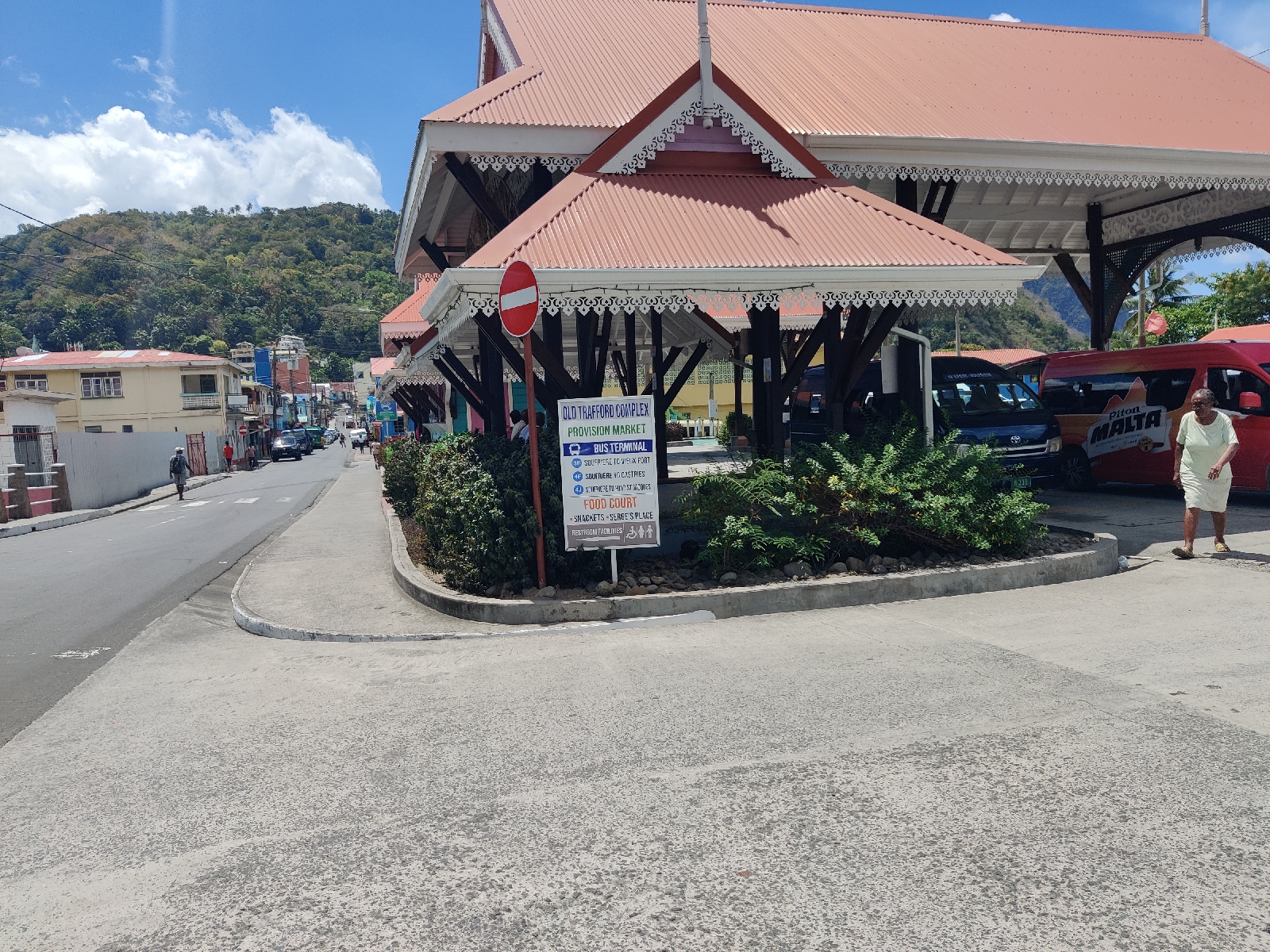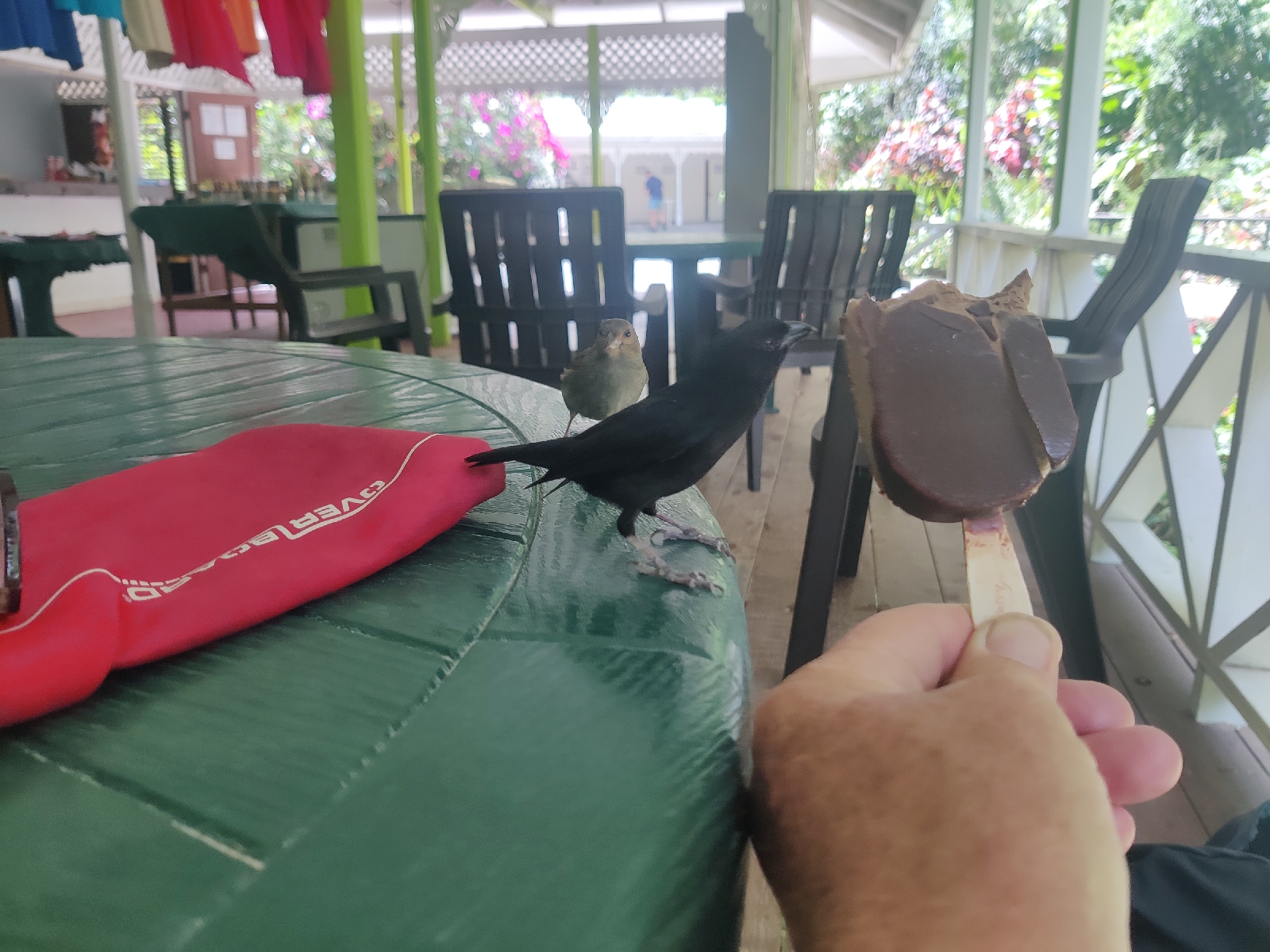Bonny - left of centre - in Pirates Bay, Tobago
We finally dragged ourselves away from our mooring in Pirates Bay, the local town of Charlotteville and the island of Tobago at 1040 on the 19th March and set sail for Saint Lucia.
We really enjoyed our time on Tobago - a beautiful, quiet island where tourism is a relatively small component of the local economy and as a consequence, neither the island or its people are overly affected by it. Not a high rise hotel in sight and no hassle, just polite enquiries from vendors who return a polite "no thank you" with an equally polite and always cheerful "enjoy your day" or similar.
A cracking sail of around 26 hours to cover the 155 miles to Soufriere on the south west coast of Saint Lucia followed. We had a fresh breeze from the East which, with the wind just forward of the beam, put us a close reach, a fairly comfortable point of sailing. The forecast of 15-20 knots of wind pursuaded me that a single reef in the mainsail and a full Genoa should provide about the right amount of sail area and whilst there were times when more sail would have provided a little more speed - our eventual average of just under 6 knots was about the most we could expect without making frequent sail changes in response to varying wind speed.
We adopted a 3 hours on, 3 hours off watch system and for the first time I took the first watch from 2100 after MIck had served up another excellent dinner - this one was single pot dish of rice and mineced beef.
By midnight I was pretty tired but as usual found it very difficult to sleep on the first (and in this case the only) night of the passage. Back on watch at 0300 I found a largely clear night with a young moon now low in the sky. For the first time I can remember since leaving Europe, Scorpio was clearly established in the southern sky behind us and with the boat surging along at near top speed it was a most enjoyable three hours. Occasionally a slight course correction was required, either in response to a slight change in wind direction or a variation in the ocean current.
We picked up a mooring at Soufriere some 26 hours later....
Bonny on a mooring under the Petit Piton near Soufriere.
Bonny's Raspberry Pi computer, coupled with a GPS receiver and the free Chartplotter software, OpenCPN, makes monitoring our progress and position so much easier than in pre-GPS days. I simply have to plot a desired course on the screen and then monitor the boat's position relative to that course. If we wander off the desired track one way or another, I make a small adjustment to the angle of the wind vane relative to the wind to bring us back on track.
Above, the thin blue line is the plotted course and the thick yellow line our actual track.
Without such luxuries, I might be able to confirm our position once or twice during a 24 hour passage with a sextant, if that is I had revised my plotting and sighting techniques sufficiently, but more likely, would be dependent on "dead reckoning" to estimate our position.
It's a time consuming process that few yachtspeople resort to these days. One needs to plot the boat's heading; the boat's speed through the water/distance travelled through the water over a given period); the amount the boat's track deviates from its heading due to leeway (sideways drift) and the direction and speed of the body of water the boat is sailing through.
Boat speed through the water can be measured reasonably accurately by a device called a log. Bonny came equipped with two ancient ones. Here's one....
And here's the other which as you can see I subsequently got going on our passage up the coast from Soufriere to Rodney Bay..
The end of the line with the propeller attached to it, is trailed behind the boat. The other end is attached to a shaft in the display unit. The shaft turns a dial via a series of gear wheels to indicate the boat's speed and another (on the first one above only) to show distance travelled. In the second one a more conventional tripometer is operated (through the water in both cases). Modern versions of the same thing, dispense with the need to trail a propeller on a piece of string, by, instead, inserting a propeller on a shaft into the water through a tube in the boat's hull. That's then connected to an eletronic display unit via a special electronic cable.
Today, nearly every boat has a GPS unit that displays its position and measures its speed over the ground in the same way as a car's satnav. That's enough to enable accurate navigation, but without a speed log it does mean you can't compare the boat's speed through the water with its speed over the ground and thereby establish the speed of any current that might exist.
A competent skipper get's to know how much leeway their boat makes, but without a GPS, the effect that ocean currents have on the boat's position can only be estimated until a fix is obtained.
To find one's estimated position without GPS, all the above variables have to be plotted on a paper chart. Only when 3 land marks or other navigational aids have been identified and bearings taken of them and plotted on the chart, can the boat's position be accurately determined, or 'fixed'.
Practice rarely makes perfect, but the few experienced sailors, who continue to practice these techniques, can make a pretty good fist of plotting a DR position over 24 or even 48 hours. After that though, even small errors mount up until the navigator has only a very general sense of where their vessel is.
Back in the 1970's, when traversing the English Channel on my Dad's old converted Lifeboat, 'Chlamys', rigged as a standing gaff cutter and endowed with an 'occasional' engine, dead reckoning was the only way to track our position.
It's worth bearing in mind that during the course of a typical 80 mile crossing from the south coast of England to the Cherbourg Penninsula or Alderney, one usually only had to endure a few hours of uncertainty between losing sight of landmarks or navigational lights on the English coast and picking up the French ones. Compare that with our 155 mile passage from Pirates' Bay Tobago to Soufriere, Saint Lucia. It's twice the distance and there are no navigational lights or other aids. Without a GPS, a navigator would be unable to fix his position for many hours and would only have the vague shapes of distant islands during the day, or the far away looms of town lights to guide them at night through the constantly changing ocean currents (as opposed to the highly predictable tidal streams of the English Channel). Take all that into account and you get a sense of how much more demanding, old school navigation would be out here, compared with home waters, or when compared with modern GPS/Chart Plotter navigation.
Back in the 1970s, even when 'just' crossing the English Channel, a good landfall was worthy of celebation. If the navigator's fix approximated closely with their EP, the rest of the crew breathed a collective sigh of relief and showered their hero with congratulatory pats on the back whilst making extravagant promises of buying beer in the pub later in the evening!
On bad days it was a different story. Here's what happened to us one fateful day back in 1974 or thereabouts, when undertaking the 80 mile crossing from Portsmouth to ...... well you'll have to read on to discover, to where.
First a bit of background.
In the 1970's, Chlamys' navigational equipment consisted of a compass and a chip log (a triangular piece of wood tied to the end of a piece of string of known length), a copy of the REEDS Nautical Almanac and a leadline (a long piece of string with a lead weight on the end for measuring the depth of water. No electronics. No internet (it hadn't even been imagined). No VHF radio, but we did have a long wave receiver for listening to the shipping forecasts
Chlamys' speed through the water was estimated by timing how long it took her to travel the length of the piece of string attached to the 'chip'.
Her heading (the direction in which her bow pointed), was worked out by subtracting or adding the magnetic variation (from True north) listed in REEDS from the heading shown on her compass - which by the way, would constantly vary around 20-30° from the prescribed course, as the helmsman made adjustments for changes in wind speed and direction.
In theory we should also have taken compass DEVIATION into account. That's the amount by which Chlamys' compass heading, deviated from the actual magnetic heading. Magnetic deviation varies by heading and is boat specific. It should be recorded in the form of a deviation chart which typically shows an 'S' shaped curve oriented over a north/south axis. In practice we never bothered because no one could steer Chlamys sufficiently accurately for the few degrees of deviation to have any practicable effect.
We estimated Leeway by looking at the boat's wake and judging the angle between it and the boat's heading. That, combined with the boat's heading, gave us the boat's direction of travel through the WATER.
Finally, the boat's direction of travel over the GROUND (COG) was estimated by adding the effects of the tidal currents - listed in REEDS and shown on the paper charts - to her track through the water.
So, with an estimate of our boat's speed and of her direction of travel - her 'COG', our navigator estimated Chlamys' position and plotted it on a paper chart every hour.
To return to the events of the day in question...
Having delayed our departure for 6 hours due to fog, we eventually left Portsmouth Harbour around midday with a forecast of fog PATCHES and little wind. The distinction between this and the previously forecasted fog BANKS, was enough to persuade an impatient skipper that the crossing was viable. So we left, confident in the knowledge that the fog PATCH that enveloped us and reduced our visibility to a couple of hundred yards (we could just make out the eastern and western extremities of the harbour entrance through the murk as we left) would soon lift.
After 6 hours of motoring the fog patch showed an uncanny ability to follow us. After 12 hours it had clearly developed a malign intent to frustrate our navigator and harrass the skipper. After 18 hours it had assumed supernatural powers of adhesion to the good ship Chlamys.
"We should be approaching the beach off Cherbourg" announced the navigator. Over went the leadline to check the depth. No bottom at 20 fathoms! "Hmm, we should have about 5 fathoms". "Lets carry on for another hour and monitor the depth" I said.
One hour later and no change. Our navigator suspected we were further west than estimated and suggested we turn east to reduce the risk of being set down the western side of the Cherbourg Penninsula and through the notorious Alderney race. 'The Race' is a channel between the rocks off the east end of the island of Alderney and the western side of the Cherbourg penninsula, where tidal currents run at up to 8 knots. Even in the absence of wind, such currents make piloting small craft extremely difficult. When strong winds blow against the current, mountenous and confused seas build up. Many a vessel has met its doom in these unforgiving waters.
After two hours heading East we turned south once again. After another two hours there was one place where I knew for certain that we weren't at - Cherbourg beach! By this time my brain had suffered a complete meltdown and I had absolutely no idea where were, or even which side of the Cherbourg Penninsula we had gone down. I was about to give the order to turn north and head back to the English coast when the fog started to slowly lift. My feelings of relief were quickly replaced by those of ... "extreme anxiety".... no, there's no other word for it ... "horror" is what I felt as less than fifty yards away, one jagged rock after another grinned hungrily at poor Chlamys and her happles crew as we slid towards them. I immediately engaged nuetral and tried to maintain a stationary position. For all I knew there were just as many rocks behind us as in front of us!
As the fog continued to lift, the scene became ever more unnerving as more and more rocks appeared out of the slowly thinning fog. It seemed miraculous that we were still afloat! Then, the hallucination was complete. A very large rock emerged - a small island in fact. Perched on top, was a small building. On top of that was a flag staff. On the flag staff flew the union flag! We had spent 24 hours steaming southwards away from the south coast of England and towards France, only, it seemed, to have arrived somewhere in Cornwall - albeit nowhere that fitted with my understanding of the Cornish coast!
Then I was convinced I was either experiencing some sort of psychotic episode or that we had slipped through a time warp into a parallel universe. Thankfully, before the crew appreciated quite how out of my depth I was, another vessel hove into view. With every vestige of sense of competence, let alone, command, having already deserted me, I (and the rest of the crew) waved and shouted at the vision before us. Soon we could make out that the returning gestures meant "follow me". So we did. Through a tortuous winding channel with rocks snapping at our flanks on both sides, as the 'oily' waters hissed and surged over the jaws of doom in the windless mist. After about 10 minutes our saviour dropped anchor amongst a clear patch of water and signalled for us to do the same.
"Someone will have to row over to ask where we are" I croaked. To a man and woman, (including the navigator) the crew made it quite clear who that someone should be. So off I went, vowing never, ever, to set foot on a boat again. On arrival, it was immediately apparent that despite the union flag fluttering nearby, our guardian angels were in fact French. At last something made a little sense. Their skipper's English was nearly as bad as my French. In the wheelhouse, with the aid of a thoroughly ancient chart which took him ages to locate (he clearly never had cause to refer to it) he showed me where we were; Les Ecrehous. A clump of rocks situated roughly halfway between Jersey and the west side of the Cherbourg Penninsula. Then he took me outside on deck and pointed west where the east end of Jersey was now just visible and gave me instructions and a sketch scribbled on a scrap of paper, for navigating the rocky channels to safety and the port of Gory about 8 miles off. His instructions ended with the words "vite, vite". I got the message - "quickly before the tide changes"!
Feeling sane once again, but still in a state of high anxiety, I rowed back to Chlamys as fast as I could, scrambled aboard and gave the order to weigh anchor as quickly as possible. Then with the aid of the sketch the French skipper had provided, we somehow escaped the jaws of hell and two hours later, tied up in Gory, mightily relieved. The booze and food consumed later in the pub tasted wonderful and that night we slept like the dead!
The next day we plotted our course backwards as it were. When we turned East, we were indeed MUCH further west than estimated - even further than we allowed for in our correction. We had also over estimated our speed and were therefore further north. Unwittingly, our final course changes took us straight down the Alderney race which we entered at high water. As the ebb tide gathered pace we shot through the race at over 10 knots over the ground until being spat out in Les Echrehous!
So, what's the difference between a piece of string and a GPS? Simple. "Peace of mind."




